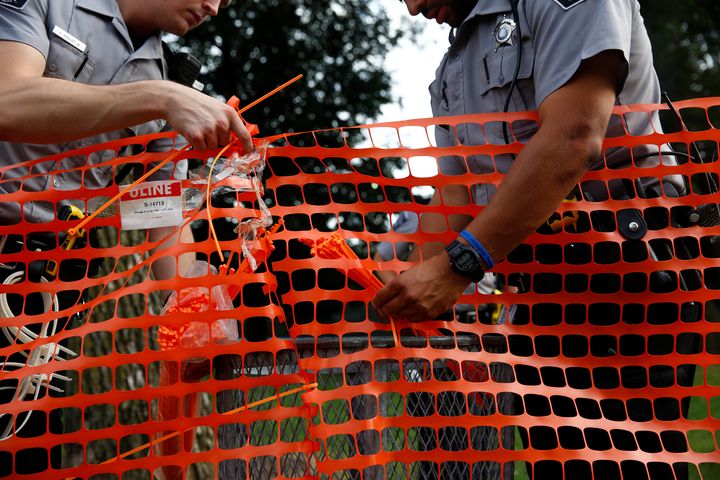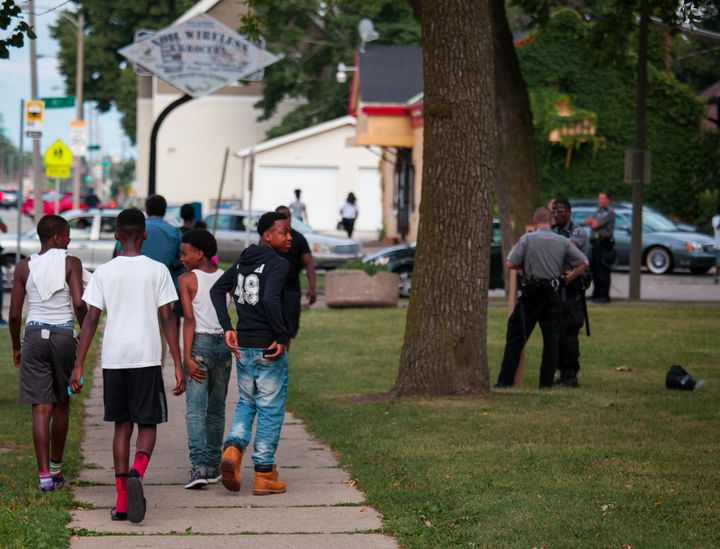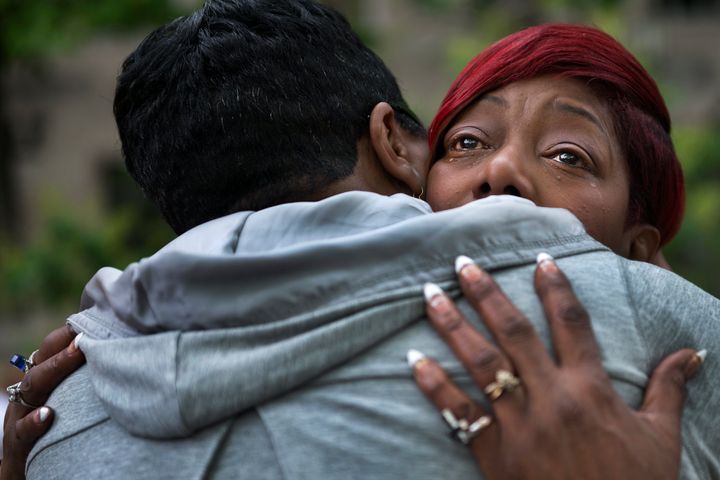
Shots fired! Shots fired!
We’ve all heard this phrase used in dozens of movies and cop shows over the years. We never stop to think about the real-world implications of these words. The implications can often be tragic for law enforcement officers, their departments, the family members of a person shot by the police and, in many instances, for the community in which it occurs.
Far too many times over the past several years, the implications of shots being fired by the police have been explosive. My home, Milwaukee, was in the national spotlight just a little over a year ago because of an officer-involved shooting.
Based on conversations I’ve had with police officers, the last thing they want to do is fire their service weapon. Despite this sentiment from law enforcement, you’d be hard pressed to convince some in the African-American community this is a true statement. Police-involved shootings have become so commonplace, we’re generally not surprised when they occur anymore. Viral videos in the aftermath of police shootings ― and especially killings of African-Americans ― has led to tremendous national debate in recent years. These events are nothing new; however, the fact that people have mobile phones and instant access to social media platforms has increased awareness of how widespread the issue has become.
On a hot day in August of last year, Milwaukee police officers pulled over a vehicle due to what they referred to as “suspicious activity.” This is not unusual in our city. The Milwaukee Police Department (MPD) routinely pulls over hundreds of thousands of drivers each year. A draft report of a U.S. Department of Justice collaborative reform initiative review, a voluntary review requested by Milwaukee Police Chief Edward Flynn, showed huge disparities in traffic stops.
Looking at data from 2013-2015:
The Milwaukee Police Department conducted 415,579 traffic stops.
African-Americans in Milwaukee made up 40 percent of the city’s population but accounted for 65.9 percent of all traffic stops.
Whites made up 37 percent of city residents but only accounted for 21 percent of traffic stops.
Even in mostly white neighborhoods, African-Americans made up a substantial percentage of people pulled over by police.
In Districts 1 and 2, where African-Americans made up 8.4 percent and 7.9 percent of the population, respectively, African-Americans represented 66 percent and 64 percent of drivers stopped by police.
In District 6, African-Americans made up only 3.1 percent of the population but represented 64 percent of traffic stops. Whites made up 70.3 percent of the population but represented only 22 percent of stops.
African-Americans were overrepresented as traffic stops in six of the seven police districts.
On Aug. 13, 2016, a routine traffic stop led to a foot chase that ended with 23-year-old Sylville Smith being shot and killed by officer Dominique Heaggan-Brown. The officer was charged with first-degree reckless homicide but found not guilty in June of this year. Within hours of the shooting, a large crowd gathered just three blocks from my home to observe the aftermath. As the crowd grew larger and more squads arrived on the scene, anger among members of the crowd eventually led to harsh words and, later, violence. Young people from around the city descended on the Sherman Park neighborhood as word of the shooting spread like wildfire on social media.

Just as the cities of Ferguson, Missouri and Baltimore, Maryland exploded in rage after the deaths of Michael Brown in 2014 and Freddie Gray in 2015, the death of Sylville Smith was the spark that led to days of civil unrest and confrontation between police and residents. Anger and frustration combined to create a toxic mixture that was the genesis of the rage that followed. Nearly a dozen businesses were set on fire, police cars were damaged and a young man was shot during the tense days following Smith’s death.
It was amazing to see the speed at which local, national and even international media deluged the area around Sherman Park, a mere five blocks from my home. From the outside looking in, it appeared the entire city was in flames. Friends and family from around the country inquired about my well-being. Most of the fires were set eight blocks away from the park itself. Only the BP gas station, which had been the scene of a controversial shooting by an employee angry about teens shoplifting that summer, was set afire in the immediate vicinity of the shooting of Smith.

Despite the limited number of fires set, perception became reality, as parts of the city were partially shut down. Those outside the area assumed the worst, while those of us close by knew it was not all that bad. The interaction between riot-clad police and civilians never erupted into the chaos we saw in Ferguson.
Race relations in Milwaukee have been strained for an extended period of time. High-profile police-involved deaths of African-Americans in the city have been happening since before I arrived in 1973 from Mississippi. Residential segregation has been the norm in the city for at least the past century. A poor relationship between the police and residents of the African-American community stretch back many decades. Discrimination in workplaces in the mid-20th century, combined with the eventual de-industrialization of the city, has created wide gaps in every measure of health and welfare of the African-American community. The events in Sherman Park brought all of the disparities to the surface.
“The death of Sylville Smith was the spark that led to days of civil unrest and confrontation between police and residents.”
African-Americans are well aware of these conditions, because we live in largely African-American neighborhoods on the north side of the city. Most whites in the metropolitan area live in neighborhoods with few people of color. Milwaukee’s metropolitan area is made up of four counties: Milwaukee, Waukesha, Ozaukee and Washington. The latter three are known as the WOW counties.
According to U.S. Census data:*
91 percent of African-Americans in the metropolitan area live within the boundaries of the city of Milwaukee.
Whites make up more than 80 percent of the population in 15 of the 18 suburbs of Milwaukee.
In six of the Milwaukee suburbs, the percentage of whites is more than 90.
Whites make up 86.4 percent of the suburban population within Milwaukee County.
In the WOW (Waukesha, Ozaukee and Washington) counties, whites make up 95.7 percent, 95.3 percent and 96.7 percent of the residents.
*Source: 2010 Census Summary File 1, Tables P5, P8, PCT4, PCT5, PCT8, and PCT11.
The 1938 Residential Security Map, also known as Redlining Map of Milwaukee, described the African-American section of town as the “Negro slum area” and prevented African-Americans from purchasing homes by making mortgages impossible to get. African-Americans were forced to rent from white owners or bought homes on contract. This arrangement made it easy to lose a home simply by being late or missing a single payment. According to historian James W. Loewen, many communities in Wisconsin were what he calls “sun down” towns. These are places where African-Americans were forced to leave town by the time the sun went down.For decades, suburban communities were kept white by the use of racial restrictive covenants. These covenants were legally enforceable “contracts” imposed in a deed upon the buyer of property and not completely outlawed until 1968. They were the primary tools used to keep African-Americans “in their place.” One such covenant, written in the city of South Milwaukee in December 1937 and set to expire in January 2024, stated unequivocally that:
At no time shall any such lot or any building thereon be purchased, owned, leased, occupied or used by any person other than Citizens of the United States of America, of the White Race. This provision shall not apply to domestic servants, which may be employed by the owner or occupant of any such lot or building thereon.
A legacy of segregation has kept African-Americans and whites living in separate worlds in Milwaukee and throughout the state. Many whites work in the city but drive home to the suburbs at the end of their workday. For a variety of reasons, many whites say they are afraid to come into the city. Many whites avoid downtown Milwaukee, not knowing that it has transformed into a nearly all-white enclave, with expensive condos and lofts sprouting up on nearly every corner over the past 10-20 years. This gentrification ― the displacement of mostly poor African-American and Latino residents ― by well-to-do whites has expanded rapidly into areas close to downtown.
Those of us in the African-American community seem to be in near constant conversations about these issues. The voices of our youth were at their loudest during the unrest last August. Few people could hear the message they were sending. The unrest led to a constant stream of conversations and suggestions about what could be done to fix the problems. Lots of promises have been made since August 2016, but most would tell you that little has changed. Money has been earmarked for projects, numerous community groups have convened meetings and a beautiful new mural has been completed recently, but no major changes have happened.
The problems in Milwaukee are big and have come to be over time. However, most of the suggested solutions are short term or will take an extended period of time to see if they have any impact. There has been a monumental shift in the nature of the economy in Milwaukee since the post-WWII days, when we were called the nation’s machine shop. For decades, the good jobs in Milwaukee were in manufacturing. Several large recessions and massive deindustrialization have wreaked havoc on our job market. African-American and Latino residents have borne the brunt of the burden this has brought about.

Up until the late-1970s, the foundation of our economy was still manufacturing. We made electrical equipment used around the world; made large numbers of small engines; produced massive amounts of leather products, manufactured locks, and car and truck frames; produced a variety of metal products in our foundries; and we were the largest producer of beer in the world ― hence our name, “Brew City.” These manufacturing facilities provided access to well-paying, stable jobs. You could work in these factories and live the American dream ― buying a home, sending your children off to college, taking nice vacations and retiring with a nice pension.
Our economy floundered as owners of these factories relocated to the suburbs, the South and eventually overseas. Factories downsized and eventually closed their doors permanently throughout the central city. A city that once had a vast network of family-supporting jobs left neighborhoods bereft of employment, and many families left the city. Big companies like A.O. Smith, Master Lock, Harnischfeger, Cutler Hammer and others left shells of themselves behind. The neighborhoods around these plants deteriorated. The Milwaukee I so fondly remembered as a child disappeared.
The mom and pop grocery stores that provided credit for families in need were no longer supportable by the residents in those neighborhoods. Budget cuts to social safety net programs under both the Carter and Reagan administrations made it increasingly difficult to survive in Milwaukee. Homes that had at one time been well taken care of began to fall into a state of disrepair. The owners no longer had the disposable income required for upkeep of the properties.
Decades of intense residential segregation had kept most African-Americans confined in the central part of the city ― in the same neighborhoods where the effects of the job losses were the worst. For some Milwaukeeans, escaping to the suburbs, which saw a smaller level of manufacturing job losses, became the obvious solution.
Eventually, the unemployment rate among African-Americans skyrocketed. This led to a mass exodus from the central city. The University of Wisconsin-Milwaukee Center for Economic Development called this a “hollowing out” of the inner city in a 2002 report. They discovered the neighborhoods designated as the inner city lost more than 45 percent of its population from 1970 through 2000. This exodus took place in the 1970s and again in the 1990s. Those who left ― in many cases poor African-Americans ― moved to the northwest part of the city or fled Milwaukee completely.
I was matriculating through high school as these changes were occurring in the late-1970s. For the most part, I did not notice them.
My family moved from Mississippi to Milwaukee in 1973. Job opportunities in Milwaukee were significantly better than in my hometown. I attended second grade my last year in Mississippi, and I had some white classmates. It had taken a long time for the schools to comply with the Supreme Court’s 1954 Brown v. Board desegregation decision. I discovered years later Milwaukee’s school system had also ignored this mandate. Attorney Lloyd Barbee sued the board of school directors in 1965 in an attempt to desegregate the schools in Milwaukee. Finally, in 1976 the Supreme Court ruled that the city must figure out how to end segregation in its schools. Three years later, they had a plan and began desegregating.
I started high school that year. I had white classmates for the first time since moving to Milwaukee. I rode the city bus to the south side of town to attend high school after attending all-African-American schools from third through eighth grade. I had never really paid attention to the fact I had no white classmates prior to this point. Nor did I notice the extreme residential segregation in Milwaukee. The segregation we see in Milwaukee currently stretches back decades. Data from the 2010 U.S. Census shows Milwaukee is the most segregated metropolitan area in the country.
Although cities like Chicago, Detroit and Cleveland are highly segregated as well, it looks demonstrably different in Milwaukee. One big factor is the demographics of the suburbs surrounding the city. Ninety-four percent of the African-Americans in Milwaukee County live within the city of Milwaukee ― even those with the economic means to live elsewhere. Those few who live in the suburbs in 2010 were concentrated in the cities of Glendale, West Milwaukee and Brown Deer, primarily.
“Although cities like Chicago, Detroit and Cleveland are highly segregated as well, it looks demonstrably different in Milwaukee.”
As the economy of the inner city deteriorated, jobs became more available in the suburbs. Inner city residents without cars have a difficult time getting to where the jobs are outside the city. Our county transit system saw major cuts under former County Executive (now Wisconsin Governor) Scott Walker. The cuts restrict access to many of the jobs in the region.
A large number of residents in Milwaukee lack valid driver’s licenses. For many years, the city would suspend driver’s licenses for two years for failure to pay municipal citations for things as trivial as jaywalking, loitering and other non-driving related offenses. It’s now been lowered to a one-year suspension, but the damage has been done. Combining this with federal cuts in funding for driver’s education programs, and you had a perfect formula for creating a crisis. Currently, nearly 30,000 African-American males in Milwaukee County don’t have a valid driver’s license.
This takes us back to the issue that led to the traffic stop that ended with the killing of Sylville Smith. In 2007, Milwaukee police registered 52,399 traffic stops. By 2012, that number had risen to 196,904. It became normal for Milwaukee police to pull people over in the African-American community. Police claim this increase was related to crime, but their own data shows that from 2007-2011, the total number of crimes in the city decreased significantly each year, from 48,040 in 2007 to only 35,528 in 2011. Other data show subject stops, also known as stop and frisk, increased from 14,258 in 2007 to 71,905 by 2012. Both types of stops have decreased significantly in recent years, but contact with police has become a constant thread in the lives of African-American males.
In April 2014, 31-year-old Dontre Hamilton was sleeping on a bench at Red Arrow Park in downtown Milwaukee ― a public park open to all. Workers at a Starbucks located in the park called police saying they were bothered by Hamilton’s presence. A squad from the Milwaukee Police Department arrived, and officers talked to Hamilton and discovered he’d done nothing wrong. The officers told the Starbucks employees that he had every right to rest in a public park if he chose to do so. The officers left, and the workers called again. The same officers returned and reiterated to the workers that Hamilton was doing nothing wrong.
Unfortunately, a second squad arrived after they left. Officer Christopher Manney came and attempted to give Hamilton a pat down. An altercation ensued, and Hamilton gained access to the officer’s baton. Manney pulled his service weapon and shot Hamilton 14 times. He died on the sidewalk at the park near the bench on which he’d been peacefully resting earlier.
The officer was eventually fired for not following department protocol ― but not for killing Hamilton. Both the District Attorney’s office and the Department of Justice failed to bring charges in the case. Manney filed a disability claim over the “stress” related to the incident prior to being fired. He’s now collecting a significant portion of his salary in disability benefits. Hamilton’s family won a settlement after three years of battle with the city.

Dontre Hamilton and Syville Smith became the Mike Brown and Philando Castille of Milwaukee ― young African-American men who died in encounters with police. Despite efforts on the part of many, there have been few substantial changes in the relationship between the police department and the African-American community since August 2016. Last February, the local American Civil Liberties Union (ACLU) filed suit against the police department over their stop and frisk policies. Police Chief Ed Flynn vigorously defends the department and denies racial animus on their part. Police and community dialogues have taken place in several neighborhoods this past year.
Despite this, tensions are still high between the African-American community and the police. Recent changes in federal immigration policies under President Trump has led many within the Latino community to fear cooperating with police. As a result, both of the largest non-white groups in the city have a poor relationship with the police.
I left Milwaukee in 1983 to join the U.S. Navy and traveled the world for six years. I returned to a city that was strange to me. Gangs from Chicago had arrived in Milwaukee by the early 1980s, and many young people from the African-American and Latino communities had joined them. Crack cocaine and other drugs flooded into the city, providing access to a new, highly visible yet in many ways underground economy. Job prospects for young African-American and Latino males became bleak due to cuts in federal jobs programs under the Reagan administration. For many, the only attractively paying jobs were involved in this new drug economy.
Even though most young men avoided this dangerous business, policing policies made them all suspects. Violent confrontations over drug territories mirrored the crime wave during Prohibition. The murder rate rose to levels unseen in the city and peaked in 1991. Innocent bystanders, including children in many cases, were caught in the crossfire. The federal War on Drugs came to Milwaukee, with millions of dollars for more police officers and eventually military hardware. More district attorneys were hired, and prisons were built at a dizzying pace ― and they began to fill up with African-American and Latino males. Eventually, we arrived at a time when Wisconsin had the highest incarceration rate of African-American males in the nation. Central city zip code 53206, where I grew up as a child, now has the highest incarceration rate in the country.
A criminal justice apparatus that acts like a revolving door is what we now have in Wisconsin. Thousands of men leave Wisconsin prisons each year, and far too many return after having their supervised release revoked. I’ve witnessed the perfect storm of mass incarceration, concentrated poverty, residential segregation and deindustrialization destroy the Milwaukee I knew as a child. The state of Wisconsin has become the worst place to live in America for African-American children, according to a study by the Annie E. Casey Foundation, which states, “Children of color face enormous barriers to educational and financial achievement — with Wisconsin ranking last in the disparity between white children and their non-white peers.” Using 12 indicators of well being, Wisconsin ranks last for African-American children and 10th best for white children.
“I’ve witnessed the perfect storm of mass incarceration, concentrated poverty, residential segregation and deindustrialization destroy the Milwaukee I knew as a child.”
It is sad to see my home undergoing such a resurgence in economic development, with billions of dollars flowing into the city in the past several years, but little of it reaching the African-American community that’s most in need. The long legacies of segregation and discrimination have cast a long shadow in Milwaukee. We still struggle to create a city where everyone can share in its success. Economic disparities still plague the city. We have the lowest numbers of African-American- and Latino-owned businesses of similar-sized cities in the nation.
I fear economic progress will continue to bypass the African-American and Latino communities, where far too many still suffer with high levels of underemployment and unemployment. Our public schools have been crushed by the weight of budget cuts over the past decade. More and more young people have become disenchanted and disconnected from the city. These young people are the ones we saw in Sherman Park last year. They feel no real connection or camaraderie with their city. The challenges we face are immense. The work required to create the type of change we’d like to see requires tremendous effort and financial resources. I work each day to bring awareness to how we’ve gotten to this place, so we as citizens can understand that the city didn’t just fall apart because people didn’t work hard enough. The people did not fail the city. The city has failed them.
